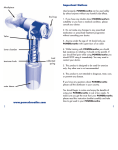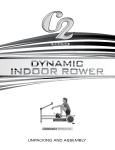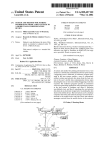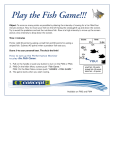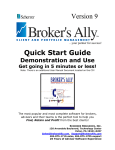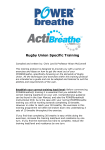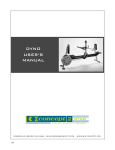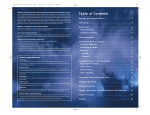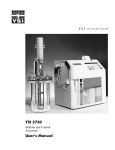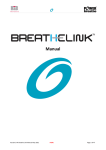Download POWERbreathe Guide for Indoor Rowers
Transcript
Contents 1. Introduction 2. The importance of the breathing muscles to rowing 3. How do you train the inspiratory muscles 4. Using POWERbreathe as part of the warm up Appendix A - Warm up pace guide References POWERBREATHE INDOOR ROWING TRAINING GUIDE | Copyright Concept2 Ltd 2006 Copyright Concept2 Ltd 2006 | POWERBREATHE INDOOR ROWING TRAINING GUIDE SECTION 01 | INTRODUCTION 1. Introduction ‘The best opportunity you will ever have to improve your indoor rowing performance’ If you could improve your race performance by 1% 2% or even 3%, reduce your breathing effort and recover faster after racing or training and all in fewer than 5 minutes a day wouldn’t it be worth while? As a user of the Concept 2 Indoor Rower (www.concept2.co.uk ) you spend huge amounts of time on technique, training your cardiovascular system and building muscle strength using weights. However, if you fail to pay the same attention to your breathing pump muscles you are neglecting to train one of the most important groups of muscles contributing to your performance. Out of sight is out of mind, but breathing is a muscular process requiring a huge amount of muscular work. This guide is written for those training to improve their 2000 m race or time trial performance. It is specifically aimed at age group rowers who are in physiological decline and want to maximise or improve their performance by strengthening their breathing muscles using the POWERbreathe (www.powerbreathe.com) inspiratory muscle trainer. The benefits of POWERbreathe apply equally to elite athletes as they do to recreational indoor rowers. My own interest stems from my breathing (asthmatic) problems which constant use of the POWERbreathe has greatly ameliorated. It occurred to me that if it could have such a dramatic effect on my meagre performance then the potential for athletic performance was huge. People with asthma have narrow lung airways, which increases the resistance to breathing, and increases the work demanded of the inspiratory muscles during exercise: the logic of training these muscles seemed obvious to me as a coach. It also seemed logical to me that rowers struggling to breathe, particularly where maximal effort is involved would benefit from having stronger breathing muscles. If you happen to be an asthmatic rower you will see a significant improvement in your breathing effort very quickly. When I checked the scientific and medical literature for information about inspiratory muscle training (IMT) I was delighted to see that not only was there good evidence that IMT improved asthma symptoms1 but also that it improved performance in highly trained young oarswomen2 and cyclists3. This strengthened my conviction that IMT was something that all my rowers should incorporate into their training. Having introduced the concept of breathing muscle training to many of my indoor rowers I am uniquely placed to demonstrate the real performance benefits of strong breathing muscles and the importance of including inspiratory muscle training in your overall training plan. POWERbreathe is a simple yet highly effective inspiratory muscle trainer, easy to use and yielding significant performance gains over a short period of time. I am indebted to Professor Alison McConnell for permission to use some of her thoughts, technical knowledge and research material in preparation of this guide. Thanks also to my group of indoor rowers for permission to use their data and for their continued support of my training methods. Special thanks to Cherrie Gayton the ‘model’ for the photographs of specific inspiratory muscles training exercises. POWERBREATHE INDOOR ROWING TRAINING GUIDE | Copyright Concept2 Ltd 2006 SECTION 01 | INTRODUCTION Eddie Fletcher MSc is a sport and exercise physiologist and coach specialising in endurance events. He is also author of the Suunto Indoor Rowing Guide. Professor Alison McConnell is Professor of Applied Physiology in the Centre for Sports Medicine and Human Performance at Brunel University. Conflict of interest statement Professor Alison McConnell has a beneficial interest in the POWERbreathe inspiratory muscle trainer in the form of a royalty share on license income to the University of Birmingham. She also acts as a consultant to Gaiam Ltd. Note: Some sections of this guide are based upon the POWERbreathe user manual and other copyrighted materials owned by Gaiam Ltd. They are reproduced with the permission. Copyright Concept2 Ltd 2006 | POWERBREATHE INDOOR ROWING TRAINING GUIDE SECTION 02 | THE IMPORTANCE OF THE BREATHING MUSCLES TO INDOOR ROWING 2 The importance of the breathing muscles to indoor rowing It is important to understand how critical your breathing muscles are to good indoor rowing performance. Rowing has a high respiratory demand, which means that your breathing muscles fatigue early. Prevailing science suggests that this high respiratory demand ‘steals’ blood from your legs during rowing which reduces your overall rowing performance4. By strengthening your breathing muscles blood flow demand by the respiratory muscles is reduced, cardiac output to your leg muscles is increased and therefore your performance will improve. The likelihood of inspiratory muscle fatigue increases with intensity of exercise above 85% of maximum oxygen uptake (VO2max)5. If you are a competitive indoor rower a significant amount of your training will be carried out above this level and during the main body of a 2000 m race or time trial you will be working above 90% of your VO2max. It has previously been thought that the weakest link in performance is the rate of oxygen delivery to the muscles i.e. the pumping capacity of the heart because breathing does not limit this process. We now know that the lungs in the words of Professor Alison McConnell are an ‘exquisite machine’ and that although the diffusion of oxygen is not a limiting step in the delivery of oxygen during exercise, breathing does limit performance. It does so because breathing is bought about by muscles, and these muscles impose their own demands upon the oxygen delivery system. However, the limitations can be significantly overcome by training the respiratory system (specifically the breathing (inspiratory) muscles). The performance of your breathing muscles determines your chest expansion and breathing performance. We know that when muscles are trained, their function improves and they become more efficient metabolically and mechanically. So it stands to reason that if you train your breathing muscles, your breathing will become more efficient, and the demands made by these muscle will decrease. We also know that training muscle makes a given task feel easier, and this also applies to the inspiratory muscles; studies have shown that POWERbreathe training reduces breathing and whole body effort 2,3. So it probably stands to reason that if you strengthen your breathing muscles under load and then remove the load for training and competition the muscles will be more efficient releasing more oxygen rich blood to other skeletal muscle lowering fatigue all round. In addition to meeting the breathing requirements of exercise, your respiratory muscles are also involved in stabilising the upper body and transmitting forces from your lower body to the handle of the ergometer. Inspiratory muscle fatigue may also impair this vital function; inspiratory muscle fatigue results in reduction in force applied at the catch. The good news is that POWERbreathe training abolishes inspiratory muscle fatigue. So what is the evidence? Let’s look at the evidence in general first: There is evidence to suggest that fatigue of the breathing muscles limits performance in a number of sports. In a 1991 experiment the inspiratory muscle strength of triathletes was measured during a triathlon of 3.8 km swim, 180 km cycle and 42 km run. No significant decline occurred during the swim but significant breathing muscle fatigue occurred after the POWERBREATHE INDOOR ROWING TRAINING GUIDE | Copyright Concept2 Ltd 2006 SECTION 02 | THE IMPORTANCE OF THE BREATHING MUSCLES TO INDOOR ROWING cycle (25%) and run (26%)6. On the shorter Sprint and Olympic distance triathlons the breathing muscles will begin to fatigue during the swim phase due to the greater intensity of effort. Further research in 2002 suggests significant improvement in 40km time trial cyclists following a period of inspiratory muscle training with POWERbreathe. In this experiment 20km and 40 km time trail performance improve by an average of 3.8% and 4.6% respectively reducing 40km time trail performance by up to 3 minutes3. Inspiratory muscle fatigue was abolished. So what evidence is there of improvement in indoor rowing performance? In a 2001 study of 14 young oarswomen inspiratory muscle strength improved by 45% and the distance covered in a six minute all-out rowing effort improved by 1.9% following inspiratory muscle training with POWERbreathe. In this same study, the gain over 5000 m rowing was even more impressive an average gain of 25 seconds2. Most of the gains occurred after only four weeks of inspiratory muscle training. Impressive gain but what are the implications for age group indoor rowers? I am indebted to my good friend Professor Alison McConnell for the following, seemingly obvious question: ‘Why do older people experience greater intensity of breathlessness during exertion than young people?’ The clue: Older people have weaker inspiratory (breathing) muscles than younger people!’ Indoor rowing is a sport that appeals to all age groups and whilst the impressive gains in experiments with young athletes cannot be ignored the question is whether older athletes are able to achieve similar results? As your body ages there are a number of physiological changes that limit performance. The ability to take up and utilise oxygen (VO2max) reduces by about 10% per decade in men and women regardless of age or exercise activity. Regular high intensity exercise may reduce this loss in young and middle aged men by 50% but not in older men and for middle aged and older women it does not appear that rates of loss can be reduced7. Muscle mass reduces, particularly fast twitch muscle and there is a consequential deterioration of the ability to produce powerful muscle contractions. Loss of strength is generalised, and includes the breathing muscles. This loss of muscle mass is most severe during the 4th decade where research has shown a decline in power of 3% per annum with 1% per annum every year thereafter8. Crucially for age group athletes the effectiveness of training for muscle strength decreases rapidly with age but my experience with POWERbreathe suggests that the inspiratory muscles remain very responsive to training. Cardiovascular and respiratory function also reduce. For rowing, research suggests that endurance capacity in men reduces by 0.12% per annum between ages 25-55 and in women 0.23% per annum8. The implication is that age groupers can continue to perform effectively for endurance events but will struggle in activities that require maximal effort. Research on young elite rowers indicates that 2000 m rowing is 65%-87% aerobic, it depends on gender and a number of other physical and physiological characteristics but is probably best described as a power endurance event so for older rowers the struggle to maintain performance is difficult. As you age you have to rely more and more on your aerobic capacity Copyright Concept2 Ltd 2006 | POWERBREATHE INDOOR ROWING TRAINING GUIDE SECTION 02 | THE IMPORTANCE OF THE BREATHING MUSCLES TO INDOOR ROWING to row a 2000 m race. This means that it is vital that the oxygenated blood is directed to the muscles that produce power against the ergometer, and that every component of the system is working as close to maximum efficiency as is possible to achieve. POWERbreathe is a vital contributor to this. If training the breathing muscles improves performance despite the aging process then the minimal effort needed is well worthwhile. My approach is never to ask athletes to undertake something that I’m not absolutely convinced is a worthwhile use of their valuable time. With this is mind, I ran my own trial of POWERbreathe. I subjected 16 age group rowers aged 36 – 63 (and randomly assigned into a training or control group) to a 1609 m maximal row at the beginning of the experiment and after 30 days of inspiratory muscle training with POWERbreathe. In the 30 day training period inspiratory muscle strength improved by a 31.8% in the training group over the control group. Seven of the eight in the training group achieved personal bests in the second 1609 m trial whilst only two in the control group lowered their personal bests Overall the average time of the training group improved by 1.8 seconds whilst the average time of the control group declined by 1.8 seconds. Statistically, the difference between the groups was significant for both inspiratory muscle strength and 1609 m rowing performance. The range of improvement over 1609 m was 0.2 seconds to 5.9 seconds after just 30 days of inspiratory muscle training. In real terms; in real athletes: Anne Yates (current 50 lwt marathon and half marathon record holder, British Indoor Rowing Champion 2004 (45-49 lwt)) improved her 1609 m performance from 6 minutes 22.3 seconds to 6 minutes 16.4 seconds and later in the year she improved her 2000 m personal best from 8 minutes 04 seconds to 7 minutes 57.3 seconds. More recently in 2006 she has reduced the 50 lwt marathon record by over 7 minutes and the half marathon record by over 4 minutes. Anne’s inspiratory muscle strength increased by a massive 54% (and is now even higher). Geoff Brimble (39 year old lwt) improved his 1609 m performance from 5 minutes 12.7 seconds to 5 minutes 09.9 seconds and his inspiratory muscle strength improved 57%. Through continued use of POWERbreathe I have recently measured his inspiratory muscle strength at 100% above his original reading! POWERBREATHE INDOOR ROWING TRAINING GUIDE | Copyright Concept2 Ltd 2006 SECTION 02 | THE IMPORTANCE OF THE BREATHING MUSCLES TO INDOOR ROWING Megan Brown (35-39 British Indoor Rowing Champion 2004/2005) already had high inspiratory muscle strength but after an improvement of 13.4% in inspiratory muscle strength she reduced her rowing time by 2.5 seconds from 5 minutes 49.4 seconds to 5 minutes 46.9 seconds. At the other end of the age range 63 year old Mike Alexander (60-64 lwt British Indoor Rowing Champion 2004) increased his inspiratory muscle strength by 18.5% and rowing time by 0.6 seconds (setting a British record) and, in a more recent training session (5 months into using POWERbreathe) he reduced his 1609 m personal best by 4 seconds. Mike also reports coping much better with his asthma and breathing, ‘in the past when I have had a cold I normally use Ventolin 2/3 times during the night and probably 3 times during the day. This time I have not used the inhaler at all and today I went back in the gym and did 3x2500 at 2min 5sec pace and 22 spm and my breathing was good. Must be the POWERbreathe!’ Let me reiterate these initial gains came after only 30 days at a fixed setting (not maximum) on the POWERbreathe. In view of Mike’s comments about his asthma it is worth mentioning that inspiratory muscle training is becoming a well established, drug-free method of managing asthma symptoms. The POWERbreathe Medic model has recently been made available on prescription due to its proven efficacy in clinical trials. Rowers with borderline symptoms who don’t qualify to medicate in competition will find inspiratory muscle training of great benefit. The conclusion I draw for older rowers is that both inspiratory muscle strength and race performance can be improved by inspiratory muscle training in both male and female age group athletes. Performance time gains may reduce with advancing age and the main benefit for some age group athletes may be in coping better with the physiological demands of indoor training and racing. All age group rowers will benefit in some way from the inclusion of POWERbreathe training into their rowing programme. Providing a rower is following a consistent and progressive training programme appropriate to their rowing ability adding POWERbreathe training will undoubtedly assist in either maintaining or improving performance. What gain is realistic? It is difficult to be definitive about the magnitude of gains that can be achieved, because everyone is different physiologically, but also because of some idiosyncrasies of the way that the ergometer expresses performance. Gains will vary from individual to individual. However everyone will gain something that allows them to cope better with the physical and physiological demands of 2000 m racing. Copyright Concept2 Ltd 2006 | POWERBREATHE INDOOR ROWING TRAINING GUIDE SECTION 02 | THE IMPORTANCE OF THE BREATHING MUSCLES TO INDOOR ROWING From my experience the gains seem to be scaled depending on the power needed to generate a set pace per 500 m. On the Concept 2 indoor rower the faster you are the more difficult it is to produce the power needed to improve performance. As the graph below shows the relationship between power (in watts) and pace is not linear but a curve. 800 700 600 500 Watts 400 300 200 100 0 0 50 100 150 200 250 300 Seaconds For instance, let’s say that hypothetical Rower 1 has a 2000 m performance of 8 minutes 24 seconds which equates to 2:06 per 500 or 175 watts: adding 25 watts would reduce the 2000 m time to 8 minutes 2 seconds giving a pace per 500 m of 2:00.5 – a gain of 22 seconds. Conversely, hypothetical Rower 2 has a 6 minute 2000 m time, which is 1:30 per 500 m or 480 watts. Increasing power in Rower 2 by 25 watts would reduce the time down to 5.51.2 giving a pace per 500 m of 1:27.8 Rower 2 gains just 8.8 seconds for the 25 watt increase in power The faster you are the harder it is to improve ergometer time, but every little helps, and even small gains make a difference between winning and losing. For arguments sake, if POWERbreathe training produced a 0.5% gain at the 6 minute level it is worth nearly 1.8 seconds; at the 8 minute 24 second level 0.5% is worth 2.5 seconds. Realistically, gains of 2-3% are possible for some indoor rowers. Worth 5 minutes extra effort a day? POWERBREATHE INDOOR ROWING TRAINING GUIDE | Copyright Concept2 Ltd 2006 SECTION 03 | HOW DO YOU TRAIN THE INSPIRATORY MUSCLES? 3 How do you train the Inspiratory Muscles? POWERbreathe is a hand held inspiratory muscle trainer that uses the tried and tested principles of resistance training. It incorporates an adjustable load, which caters for all capabilities and permits progressive training. In order to breathe in, you must overcome the tension of the spring, allowing the valve to open. The amount of effort and inspiratory muscle force applied to the POWERbreathe depends upon the opening pressure set on the inspiratory valve. . The makers of POWERbreathe describe their device as ‘dumb-bells’ for your diaphragm, which will for a few minutes daily, make your inspiratory muscles work harder – thereby increasing your strength and endurance. Within a few days inspiratory (breathing) muscles will feel stronger and within four weeks performance, will improve. Inspiratory muscle training should be seen as weight training for your breathing muscles and demands the same care and attention that is given to other aspects of your training programme. It needs to be based on the application of scientific principles of intensity and repetitions, progressive development of intensity over time. It should also be as specific to indoor rowing as possible and should therefore be part of structured periodised training programmes. The benefit of training your breathing muscles can be achieved in as little as four weeks. The POWERbreathe inspiratory muscle trainer may also be incorporated into warm up routines to further improve performance (see section 4). As a minimum the best way to start inspiratory muscle training is to follow the POWERbreathe instructions, which are included with your POWERbreathe (see also www.powerbreathe.com). It is important to follow the correct technique and progressively increase the training load to obtain maximum benefits. The gains to be had from training the breathing muscles are significant so do not neglect this important aspect of your training Copyright Concept2 Ltd 2006 | POWERBREATHE INDOOR ROWING TRAINING GUIDE SECTION 03 | HOW DO YOU TRAIN THE INSPIRATORY MUSCLES? Using your POWERbreathe – the basics It is recommended that you use your POWERbreathe twice a day, in the morning and at night, each time following a simple routine: 1. Make sure you are sitting or standing upright and feel relaxed. 2. You should aim to complete 30 breaths each session, and for these to be undertaken at the 30 repetition maximum load; in other words, the load should be such that you cannot complete more than 30. If you start to feel lightheaded, slow down and pause at the end of your breath out, before taking the next breath in. 3. Don’t worry if you can’t manage to complete 30 breaths straight away. Everyone is different and it can take time to build up your breathing muscles. 4. If you can complete 30 breaths with ease, turn the tensioner knob to the right to increase the training load. In this way, by a process of trial and error, you will be able to find the optimal training level for you…the key is to be just able to complete 30 breaths. 5. Use your POWERbreathe on this new setting, still aiming to complete 30 breaths. You should find breathing in a little harder and may not be able to complete a full session. But within a few days you will, so persevere. 6. The aim is to continue adjusting your POWERbreathe so that it is challenging - but not painful - so that you can only just complete 30 breaths in a session. REMEMBER: Everyone is different. Using your POWERbreathe is not a race to get the tensioner knob to the highest position. Some people may never be able to achieve 30 breaths with the tensioner knob at its starting point, but the exercise can still benefit their breathing. On the other hand, you may progress rapidly and find it necessary to adjust your POWERbreathe every four or five days. Getting the most out of your POWERbreathe You should begin to enjoy the benefits of your POWERbreathe within the first one to two weeks of use and your breathing power should have improved substantially after four to six weeks. At this stage you will not need to use your POWERbreathe every day to maintain your improved breathing. Using your POWERbreathe every other day will be sufficient, however, if you want to squeeze out as much benefit as possible from your POWERbreathe, read on... POWERbreathe-Training for performance POWERbreathe is like any other kind of training – you get out what you put in. If you are using POWERbreathe to enhance your performance, you may want to push yourself a little harder. When training for performance with POWERbreathe, use the same “30 breaths twice a day” training programme, but be aware you will only achieve optimum benefits when you train "hard". In other words, breathe as deeply and forcefully as you possibly can and aim to reach "overload" within 30 breaths. "Overload" means you should be unable to open the valve properly POWERBREATHE INDOOR ROWING TRAINING GUIDE | Copyright Concept2 Ltd 2006 SECTION 03 | HOW DO YOU TRAIN THE INSPIRATORY MUSCLES? by the time you reach 30 breaths. If you find that you can manage 34 breaths with ease, increase your training load by a quarter of a turn. This may mean that you can only achieve 26 breaths or so next session, but stick at it – within a few days you will be back up to 30 again. In this way you are always training to the "max". This intensity of training is quite strenuous and we only recommend it for those users who are accustomed to hard physical activity. Professor Alison McConnell has identified a routine that works for time trials between 6 and 60 minutes duration, in rowing, cycling and running, i.e., 30 repetition maximum load executed with maximal effort. The latter is important because it ensures that the muscle recruitment is maximal, i.e., as many muscle fibres as possible are forced to contract against the load. Specific inspiratory muscle training exercises for indoor rowing From a practical point of view it would make sense to train the inspiratory muscles under the conditions where they experience the greatest challenge i.e. when rowing Catch Inhale Drive Exhale Finish Inhale Copyright Concept2 Ltd 2006 | POWERBREATHE INDOOR ROWING TRAINING GUIDE SECTION 03 | HOW DO YOU TRAIN THE INSPIRATORY MUSCLES? Professor McConnell and I have identified a number of rowing postural challenges that appear to benefit from ‘posture-specific’ inspiratory muscle training. Rowers normally inhale at two points in the stroke (just before the catch and just after the finish); the largest breath being just after the finish. Both of these points in the stroke impose restrictions on breathing; at the finish, the hips are extended and the shoulders are behind the hips. This means that the muscles of the torso (including the inspiratory muscles) must work against gravity to prevent the rower from falling backwards. At the same time, the rower needs to take a large, fast breath, which means that the inspiratory muscles are subjected to competing demands for postural stability and breathing. Once the rower reaches the catch, they must take another breath, but in this position, the movement of the diaphragm is impeded by the crouched body position. At the catch, the abdomen is compressed by the thighs pushing the liver, stomach and gut upwards against the diaphragm. This compression makes it harder for the diaphragm to contract, flatten and move downwards, as it must do in order to inflate the lungs. Rowing specific inspiratory muscle exercises I recommend three exercises that are designed with posture specificity in mind, but they should only be attempted after a 4 week period of traditional, upright training to provide a ‘base’: ‘Catch’ – For this exercise, the abdomen needs to be compressed by bending forward from a standing position and grasping the ankles. The knees should be slightly bent and pushing against your abdomen. The required number of inspiratory repetitions (breaths) is then undertaken in this posture using your POWERbreathe. This exercise is very tough and may require a step down in the training load setting on the POWERbreathe when getting started. Emphasis must be given to maximising the volume of each breath, inhaling the breath as quickly as possible, and focussing on using the diaphragm to get maximum benefit. POWERBREATHE INDOOR ROWING TRAINING GUIDE | Copyright Concept2 Ltd 2006 SECTION 03 | HOW DO YOU TRAIN THE INSPIRATORY MUSCLES? ‘Catch’ It is also possible to undertake this ‘Catch’ exercise on the rowing machine using a normal catch or overreaching position to compress the abdomen. Normal and overreaching catch position Copyright Concept2 Ltd 2006 | POWERBREATHE INDOOR ROWING TRAINING GUIDE SECTION 03 | HOW DO YOU TRAIN THE INSPIRATORY MUSCLES? ‘Drive’ – Although breathing in during the drive is not to be recommended, ensuring that the inspiratory muscles are capable of rising to this challenge may be advantageous. A high resistance rubber cord with handles is required for this exercise. The exercise is undertaken in a seated position with the feet together and legs extended. The cord should be wrapped around the feet and pulled (as if rowing); simultaneously, an inhalation is made through the POWERbreathe for the required number of repetitions. A more advanced version of this exercise would be to use a seated row weight machine in the gym to simulate the arm pull of the drive. An upright row with barbell or dumbbells is a further modification of this exercise. In all cases, the inspiratory effort should be made through the POWERbreathe at the same time as you lift/pull the weight/ resistance. A further more specific exercise would be to inhale whilst on the rowing machine in the mid drive position or by using an up right row. ‘Drive’ Inhale ‘Drive’ Exhale POWERBREATHE INDOOR ROWING TRAINING GUIDE | Copyright Concept2 Ltd 2006 SECTION 03 | HOW DO YOU TRAIN THE INSPIRATORY MUSCLES? Upright row ‘Finish’ – A core stability accessory such as a ‘Swiss Ball’, or ‘Balance Ball’ is needed for this exercise. The body should be positioned so that the upper body muscles are engaged in postural stabilisation activity, such as sitting on the ball, slightly extended at the hip, with the shoulders leaning back behind your centre of gravity. Next, the required number of repetitions is executed. A more advanced version would be to sit on the ball without the feet in contact with the floor. Normal and extended finish position As with the catch and drive position it is also possible to undertake this ‘Finish’ exercise on the rowing machine using a normal finish or extended position. Copyright Concept2 Ltd 2006 | POWERBREATHE INDOOR ROWING TRAINING GUIDE SECTION 03 | HOW DO YOU TRAIN THE INSPIRATORY MUSCLES? Normal and extended finish position No empirical testing of these postural approaches has been undertaken. However Professor McConnell’s opinion is that it would be very hard to differentiate quantitatively any enhancement due to the application of posture-specific inspiratory muscle training vs. traditional inspiratory muscle training, given the relatively small absolute magnitude of improvement that is involved. However, feedback from the rowers she has worked with suggests that they notice a difference at crucial times when the going gets tough. Since it’s the tough points in a 2000 m race that are pivotal in its ultimate outcome this is significant feedback. POWERBREATHE INDOOR ROWING TRAINING GUIDE | Copyright Concept2 Ltd 2006 SECTION 03 | HOW DO YOU TRAIN THE INSPIRATORY MUSCLES? Review of the rowing specific inspiratory muscle exercises 1. ‘Catch’ 2. ‘Drive’ Inhale ‘Drive’ Exhale 3. ‘Finish’ Copyright Concept2 Ltd 2006 | POWERBREATHE INDOOR ROWING TRAINING GUIDE SECTION 04 | USING POWERBREATHE AS PART OF THE WARM UP Using POWERbreathe as part of the warm up for a 2000 m race or time trial Research has shown that a normal warm up routine neglects your breathing muscles so using POWERbreathe as part of your warm up routine will enhance your performance; improvements in the region of 1% have been observed in the laboratory. Before describing how to use the POWERbreathe in warm up it is appropriate to review the purpose of a warm up and also to describe a specific warm up routine that indoor rowers can use prior to racing. The purpose of a warm up is to increase muscle and core temperature, blood flow and improve the uptake, transport and utilisation of oxygen as well as providing a comfortable way to lead into a 2000 m race. A warm up should progress gradually and provide sufficient intensity to increase muscle and core temperature without causing fatigue or reduced energy stores (it should make you sweat and feel slightly breathless). Warm up may need to vary depending on the environmental conditions (hot or cold venue) and should be completed within a few minutes of the race (recommend 10 minutes). Warm up stretches the muscle tendons allowing greater length and less tension on exposure to the fast start to a race. Injuring a warmed up muscle requires greater force than required to injure a cold muscle. A 1991 study suggested that a warm up produces higher temperature, higher oxygen consumption and lower blood lactate in the first minute of exercise than no warm up (a considerable benefit for a fast 2k start). Whilst more research is required to fully authenticate warm up procedures physiologists generally agree that correct warm up improves physical performance and exercise capacity by increasing blood flow, muscle and core temperature and oxygen delivery. The warm up I recommend for a 2000 m race is of 20 minutes duration. For 18 minutes intensity is 50-60% of 2k power – a level equivalent to low aerobic training interspersed with 3 short (30-45 seconds) sprints at 77%, 91% and 108% of 2k power. This should be sufficient to increase muscle and core temperature without fatiguing or losing energy. This warm up protocol is taken from a research paper that I believe has credibility and certainly appears to be effective for my rowers that have used it2. I recommend that all indoor rowers should use this warm up protocol in training before any high intensity sets – 1250, 750s and 500s so that on race day it becomes just normal race preparation. For those of you who suffer with exercise induced breathlessness of any description warm up is paramount as the initial moderate intensity can help to prevent exercise-induced asthma. However, if you are under medical care for asthma, and exercise triggers a response, use your inhaler prior to training and competition. It is also important that you check on the competition rules regarding the use of inhalers in competition before taking any medication. POWERBREATHE INDOOR ROWING TRAINING GUIDE | Copyright Concept2 Ltd 2006 SECTION 04 | USING POWERBREATHE AS PART OF THE WARM UP Warm down is as important as warm up. It helps to reduce the lactic acid build up, return heart rate, core temperature and breathing to normal and prevent stiffness. 10 minutes of gentle rowing can be sufficient to reduce lactic levels to near normal. Again particularly important if you suffer post race breathlessness. I know it is difficult to get on the warm up machines post race, but it is well worth the effort. So how does the warm up work: Example – for a rower with a 7 minute 2000 m time (1:45 per 500 m 302 watts) Time 4’ 4’ 3’ 1’ 30” 2’ 45” 2’ 30’ 2’ % of 2000m Watts 50% 55% 57.5% 60% 77% 50% 91% 50% 108% 50% Pace 2:12 2:08 2:06 2:04 1.53 2:12 1:48 2:12 1.42 2:12 To find your individual warm up use the look up chart in Appendix A Including POWERbreathe as part of the warm up You first need to establish your current POWERbreathe training level by checking the numerical scale on the POWERbreathe, or the number of circular ‘steps’ visible on the lower chamber (if you have the older model). For new models with the numerical scale use the following table to identify the appropriate warm-up load: Current Training Load Ideal Warm-up Load Level 9 Level 7 Level 8 Level 6 Level 7 Level 5.5 Level 6 Level 4.5 Level 5 Level 4 Level 4 Level 3 Level 3 Level 2 Level 2 Level 1.5 Level 1 Level 0.5 Level 0 Level 0 Copyright Concept2 Ltd 2006 | POWERBREATHE INDOOR ROWING TRAINING GUIDE SECTION 04 00 | USING HEADING POWERBREATHE AS PART OF THE WARM UP Users with older POWERbreathe models should look at the position of the pointer on the tensioner knob relative to the steps on the spring housing chamber. If, for instance you can only see one line circle visible on the chamber your level is high, if you a can see two lines your level is medium and if all three are visible then you are using a low training level. Reduce the load on your POWERbreathe by three turns if your level is high, two if it is medium and one if it is low. Perform two sets of 30 breaths with 1-2 minutes rest between each set. Try to breathe in fully but avoid maximum effort. You should do this immediately after completing your rowing warm up. POWERBREATHE INDOOR ROWING TRAINING GUIDE | Copyright Concept2 Ltd 2006 SECTION 00 | HEADING Appendix A RACE WARM UP PACE GUIDE Time Stroke Rate 2k timePer 500m PACE 5.40 5.44 5.48 5.52 5.56 6.00 6.04 6.08 6.12 6.16 6.20 6.24 6.28 6.32 6.36 6.40 6.44 6.48 6.52 6.56 7.00 7.04 7.08 7.12 7.16 7.20 7.24 1.25 1.26 1.27 1.28 1.29 1.30 1.31 1.32 1.33 1.34 1.35 1.36 1.37 1.38 1.39 1.40 1.41 1.42 1.43 1.44 1.45 1.46 1.47 1.48 1.49 1.50 1.51 4' 18 4' 20 3' 22 1' 24 30s 26-28 2' 18 45s 28-30 2' 18 30s 30-34 2' 18 1.49 1.50 1.51 1.52 1.53 1.54 1.55 1.56 1.57 1.58 2.00 2.01 2.02 2.04 2.05 2.06 2.08 2.09 2.10 2.11 2.12 2.13 2.14 2.16 2.18 2.19 2.20 1.45 1.46 1.47 1.48 1.49 1.50 1.51 1.52 1.54 1.55 1.56 1.57 1.58 2.00 2.01 2.02 2.04 2.05 2.06 2.07 2.08 2.09 2.10 2.12 2.13 2.14 2.16 1.44 1.45 1.46 1.47 1.48 1.49 1.50 1.51 1.52 1.53 1.54 1.55 1.56 1.57 1.58 2.01 2.02 2.03 2.04 2.05 2.06 2.07 2.08 2.09 2.10 2.11 2.13 1.42 1.43 1.44 1.45 1.46 1.47 1.48 1.49 1.50 1.51 1.52 1.54 1.55 1.56 1.57 1.59 2.00 2.01 2.02 2.03 2.04 2.05 2.06 2.07 2.08 2.09 2.11 1.33 1.34 1.35 1.36 1.37 1.38 1.39 1.40 1.41 1.42 1.43 1.44 1.45 1.46 1.47 1.48 1.49 1.50 1.51 1.52 1.53 1.54 1.55 1.56 1.57 1.58 1.59 1.49 1.50 1.51 1.52 1.53 1.54 1.55 1.56 1.57 1.58 2.00 2.01 2.02 2.04 2.05 2.06 2.08 2.09 2.10 2.11 2.12 2.13 2.14 2.16 2.18 2.19 2.20 1.28 1.29 1.30 1.31 1.32 1.33 1.34 1.35 1.36 1.37 1.38 1.39 1.40 1.41 1.42 1.43 1.44 1.45 1.46 1.47 1.48 1.49 1.51 1.52 1.53 1.54 1.55 1.49 1.50 1.51 1.52 1.53 1.54 1.55 1.56 1.57 1.58 2.00 2.01 2.02 2.04 2.05 2.06 2.08 2.09 2.10 2.11 2.12 2.13 2.14 2.16 2.18 2.19 2.20 1.22 1.23 1.24 1.25 1.26 1.27 1.28 1.29 1.30 1.31 1.32 1.33 1.34 1.35 1.36 1.37 1.38 1.39 1.40 1.41 1.42 1.43 1.44 1.45 1.46 1.47 1.48 1.49 1.50 1.51 1.52 1.53 1.54 1.55 1.56 1.57 1.58 2.00 2.01 2.02 2.04 2.05 2.06 2.08 2.09 2.10 2.11 2.12 2.13 2.14 2.16 2.18 2.19 2.20 Copyright Concept2 Ltd 2006 | POWERBREATHE INDOOR ROWING TRAINING GUIDE SECTION 00 | HEADING RACE WARM UP PACE GUIDE Time 4' Stroke Rate 18 2k timePer 500m PACE 7.28 7.32 7.36 7.40 7.44 7.48 7.52 7.56 8.00 8.04 8.08 8.12 8.16 8.20 8.24 8.28 8.32 1.52 1.53 1.54 1.55 1.56 1.57 1.58 1.59 2.00 2.01 2.02 2.03 2.04 2.05 2.06 2.07 2.08 2.21 2.22 2.24 2.25 2.26 2.27 2.28 2.29 2.30 2.32 2.33 2.35 2.37 2.38 2.39 2.40 2.41 4' 20 3' 22 1' 24 30s 26-28 2' 18 45s 28-30 2' 18 30s 30-34 2' 18 2.17 2.18 2.19 2.20 2.21 2.22 2.24 2.26 2.27 2.29 2.30 2.31 2.32 2.33 2.34 2.35 2.37 2.15 2.16 2.17 2.19 2.20 2.21 2.22 2.23 2.24 2.26 2.27 2.28 2.29 2.30 2.31 2.32 2.33 2.13 2.14 2.15 2.16 2.17 2.18 2.20 2.21 2.22 2.24 2.25 2.26 2.27 2.28 2.29 2.30 2.31 2.01 2.03 2.04 2.05 2.06 2.07 2.08 2.09 2.10 2.11 2.12 2.13 2.14 2.15 2.16 2.17 2.18 2.21 2.22 2.24 2.25 2.26 2.27 2.28 2.29 2.30 2.32 2.33 2.35 2.37 2.38 2.39 2.40 2.41 1.56 1.57 1.58 1.59 2.00 2.01 2.02 2.03 2.04 2.05 2.06 2.07 2.08 2.09 2.10 2.11 2.12 2.21 2.22 2.24 2.25 2.26 2.27 2.28 2.29 2.30 2.32 2.33 2.35 2.37 2.38 2.39 2.40 2.41 1.49 1.50 1.51 1.52 1.53 1.54 1.55 1.56 1.57 1.58 1.59 2.00 2.01 2.02 2.03 2.04 2.05 2.21 2.22 2.24 2.25 2.26 2.27 2.28 2.29 2.30 2.32 2.33 2.35 2.37 2.38 2.39 2.40 2.41 POWERBREATHE INDOOR ROWING TRAINING GUIDE | Copyright Concept2 Ltd 2006 SECTION 00 | HEADING References: 1. Weiner, P. Azgad, Y. Ganam, R. Weiner, M. (1992). Inspiratory muscle training in patients with bronchial asthma. Chest, 102, (5), 1357-1361. 2. Volianitis, S. McConnell, A. K. Koutedakis, Y. McNaughton, L. Backx, K. & Jones, D.A. (2001). Inspiratory muscle training improves rowing performance. Medicine & Science in Sports & Exercise, 33, (5), 803-809. 3. Romer, L. M. McConnell, A.K. & Jones, D.A. (2002). Inspiratory muscle fatigue in trained cyclists: effects of inspiratory muscle training. Medicine & Science in Sports & Exercise, 34, (5), 785-792. 4. Harms, C. A. Babcock, M. A. McClaran, S. R. Pegelow, D. F. Nickele, G. A. Nelson, W. B. & Dempsey, J. A. (1997). Respiratory muscle work compromises leg blood flow during maximal exercise. Journal of Applied Physiology, 82, 1573-1583. 5. Johnson, B.D. Babcock, E.A. Suman, O.E. & Dempsey, J.A. (1993). Exercise induced diaphragmatic fatigue in healthy humans. Journal of Physiology, 460, (1), 385-405. 6. Hill, N.S. Jacoby, C. and Farber, H.W. (1991). Effect of an endurance triathlon on pulmonary function. Medicine & Science in Sports & Exercise, 23, (11), 1260-1264. 7. Hawkins, S.A. & Wiswell, R.A. (2003). Rate and mechanism of maximal oxygen consumption decline with aging. Sports Medicine, 33, (12), 877-888. 8. Galloway, M. T. Kadoko, R. Jokl, P. (2002). Effect of aging on male and female master athletes’ performance in strength versus endurance activities. American Journal of Orthopedics, 31, (2), 93-98. This Guide has been written by Eddie Fletcher in collaboration with Professor Alison McConnell Copyright Concept2 Ltd 2006 | POWERBREATHE INDOOR ROWING TRAINING GUIDE


























